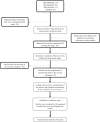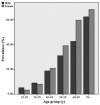Prevalence of Hypertension in Iran 1980-2012: A Systematic Review
- PMID: 28496506
- PMCID: PMC5424849
Prevalence of Hypertension in Iran 1980-2012: A Systematic Review
Abstract
Background: The high prevalence of hypertension and concomitant increase in the risk of its related disease makes it an important health concern all over the world. Hypertension is one of the 5 global leading causes of mortality in the world. Little is known about the current prevalence of hypertension in Iran, however. This systematic review aimed to investigate the current prevalence of hypertension in Iran. Methods: A systematic review of hypertension was conducted using international databases, including Medline (PubMed) and Science Direct (Scopus), and Persian scientific databases. The searched keywords were "hypertension", "raised blood pressure", "prevalence", and "Iran". All original articles in English published from 1980 to 2012 were included. After data extraction, heterogeneity between studies and publication bias was assessed and effect size was pooled by the random effect model. Results: Forty-two studies with 402 282 subjects were included. The estimated prevalence of hypertension varied all around Iran (I2 = 99%). The overall pooled prevalence of hypertension was 22% (95%CI: 20.2 - 23.8). The prevalence of hypertension was 23.6% (95%CI: 21.1 - 26.1) in men and 23.5% (95%CI: 20.2 - 23.8) in women. In urban areas, the prevalence of hypertension was 22.1% (95%CI: 19.4 - 24.7). Ten studies investigated the prevalence of hypertension in rural areas and according to the random effect model, the prevalence of hypertension in rural areas was 18.6% (95%CI: 13.6 - 23.6). Nonsignificant publication bias was found in this review (p value = 0.18). In our meta-regression analysis, only mean age and study quality were associated with significant variability. Conclusion: According to this study, hypertension is one of the most common health problems in Iran. Around one-quarter of the adult population is hypertensive and its prevalence increases by aging. Timely and appropriate public health strategies are essential for the improvement of the screening, treatment, and control of hypertension.
Keywords: Hypertension; Iran; Review literature as topic; Root cause analysis.
Figures




References
-
- Lewington S, Clarke R, Qizilbash N, Peto R, Collins R. Prospective Studies Collaboration. Age-specific relevance of usual blood pressure to vascular mortality: A meta-analysis of individual data for one million adults in 61 prospective studies. Lancet. 2002;360:1903–1913. - PubMed
-
- Lawes CM, Rodgers A, Bennett DA, Parag V, Suh I, Ueshima H, MacMahon S. Asia Pacific Cohort Studies Collaboration Blood pressure and cardiovascular disease in the Asia Pacific region. J Hypertens. 2003;21:707–716. - PubMed
-
- MacMahon S, Peto R, Cutler J, Collins R, Sorlie P, Neaton J, Abbott R, Godwin J, Dyer A, Stamler J. Blood pressure, stroke, and coronary heart disease Part 1, prolonged differences in blood pressure: prospective observational studies corrected for the regression dilution bias. Lancet. 1990;335:765–774. - PubMed
-
- Woodward M, Barzi F, Martiniuk A, Fang X, Gu DF, Imai Y, Lam TH, Pan WH, Rodgers A, Suh I, Jee SH, Ueshima H, Huxley R. Asia Pacific Cohort Studies Collaboration Cohort profile: the Asia Pacific Cohort Studies Collaboration. Int J Epidemiol. 2006;35:1412–1416. - PubMed
Publication types
LinkOut - more resources
Full Text Sources
